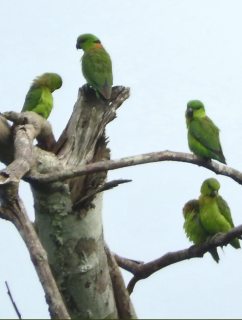Black-collared Lovebird |
|
|
Also known as: Swindern's Lovebird, Liberian Lovebird
Photos
View in GalleryDid You Know?
The Black-collared Lovebird is an arboreal termitaria nester (it nests in termite mounds in trees.)Academic Research
Related publications: Agapornis swindernianusSpecies Profile
Genus: Agapornis | Species: swindernianus
Size:
13cm (5 in)
Weight:
39-40g (1.3-1.4 oz)
Subspecies including nominate:
three: A.s. swindernianus, A.s. zenkeri, A.s. emini
Colour Adult:
A.s. swindernianus: Both adults mostly green; nuchal collar narrow and black; dull yellow neck below collar; deep lilac/blue lower back to upper tail coverts; black primary coverts; black primary and outer secondary feathers; green underwing coverts; green tail, with red lateral feathers at base and banded with black before tip. Bill grey/black. Eye yellow.
A.s. zenkeri: Both adults neck red/brown below black collar, reaching to breast as wash.
A.s. emini: Both adults as in zenkeri, but less far reaching red/brown on neck and breast.
Colour Juvenile:
A.s. swindernianus: Black nuchal collar missing; paler blue lower back to upper tail coverts; dull orange lateral tail feathers at base. Bill pale grey with black at base. Eye brown.
A.s. zenkeri: Neck entirely green with black nuchal collar absent; otherwise as in swindernianus.
A.s. emini: As in zenkeri.
Call:
Calls are subdued and twittering. Some are rapidly repeated and shrill. Loud screeches when alarmed.
More Information:
Content Sources:
CITES
Cornell Lab of Ornithology/Birds of the World
BirdLife International
Parrots: A Guide to Parrots of the World, Juniper and Parr, 1998
Parrots of the World, Forshaw, 2006. 2010 edition
Parrots in Aviculture, Low, 1992.
Lexicon of Parrots, Thomas Arndt.
Photos
View in GalleryDid You Know?
The Black-collared Lovebird is an arboreal termitaria nester (it nests in termite mounds in trees.)Academic Research
Related publications: Agapornis swindernianusSpecies Care
Captive Status:
Not generally found in aviculture.
Longevity:
Not recorded.
Housing:
Enclosure or aviary, indoors or outdoors if in warm climate, minimum length 1.2m (4 ft).
Diet:
Small seed mixture, containing mainly canary, millet and oats with a little hemp in cold weather; fruits such as: apple, pear, and others if taken; green leaves such as: Swiss chard, lettuce, kale, sowthistle, dandelion, chickweed; willow catkins; spray millet; rearing food made from: hardboiled egg, wholegrain bread and carrot, all ground to crumbly consistency, to be given when rearing young; complete kibble for lovebirds.
Enrichment:
Not recorded.
Nest Box Size:
Not recorded.
Clutch Size:
Not recorded.
Incubation Time:
Not recorded.
Fledging Age:
Not recorded.
Hatch Weight:
Not recorded.
Peak Weight:
Not recorded.
Weaning Weight:
Not recorded.
Photos
View in GalleryDid You Know?
The Black-collared Lovebird is an arboreal termitaria nester (it nests in termite mounds in trees.)Academic Research
Related publications: Agapornis swindernianusSpecies Wild Status
World Population:
Unknown.
IUCN Red List Status:
Least Concern
CITES Listing:
Appendix II
Threat Summary:
Is rare in Liberia and Ghana, where it is likely confined to forest reserves. Rare in Dzanga reserves in Central African Republic and rarely recorded in E Africa. Reasonably common in the Bwamba lowlands, Uganda.
Range:
A.s. swindernianus: Liberia, Ivory Coast and Ghana.
A.s. zenkeri: C Africa from southern Cameroon to Gabon and east to W Democratic Republic of Congo and SW Central African Republic.
A.s. emini: C Democratic Republic of Congo to far W Uganda.
Habitat:
Found up to 1800m (5904 ft) in lowland evergreen rainforest, both primary and secondary forest, and occasionally in cultivated areas.
Wild Diet:
Feeds on strangler Ficus fig seeds, millet, maize and other seeds, insects and their larvae. Also the fruits of Rauwolfia, Harungana and Macaranga.
Ecology and Behaviour:
Stays up in forest canopy, mainly in tree tops where birds are very difficult to spot. Forms communal roosts at dusk sites that are re-visited frequently. Generally seen in small flocks of 20 or more birds.
Clutch and Egg Size:
Not recorded.
Breeding Season:
Nestlings have been seen January–February in Gabon.
Photos
View in GalleryDid You Know?
The Black-collared Lovebird is an arboreal termitaria nester (it nests in termite mounds in trees.)Academic Research
Related publications: Agapornis swindernianusMembers Only Resources
Please log-in now to find more research, resources and tools.
Not a Member?
Find more great information:
Gain exclusive access to 600+ pages of additional research, seminars and podcasts, specialists to ask your toughest questions, and dozens of other fun resources - when you become a WPT member.
Join Today >>

































